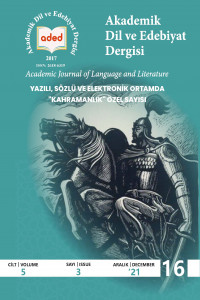Abstract
Anlatmaya dayalı edebî eserlerin önemli bir parçası olan kahraman, tahkiyeyi şekillendiren unsurların başında gelir. Kahraman, destanlarda merkezi bir rol oynar. Doğumu, ad alması, silah ve binit sahibi olması, mücadelesi ve nihayetinde de ölümü olağanüstülükler taşır. Kahramanın etrafında şekillenen bu safhalar aynı zamanda yaratıldığı ve mensubu olduğu toplumun insan, dünya, yaşam ve mücadele anlayışını yansıtır. Bir anlamda kahramanı çözümlemek demek, sadece yaratmanın yapısal çözümlemesini yapmak değil; aynı zamanda yaratıldığı toplumun kültürel kodlarını tanımlamak anlamına gelir. Bu bağlamda ele alındığında destanlar ve kahramanları; bu çalışma özelinde de bilhassa kadın kahramanlar, mensubu oldukları toplumun kadın algısını ve kadına karşı bakış açılarına dair de önemli veriler sunar. Bu verilerin değerlendirilmesi toplumların değişim ve dönüşüm süreçlerinin daha yakından tanınmasına olanak sağlar. Bunun yanında da destan gibi kahramanın idealize edildiği metinlerin toplum-insan ölçeğindeki yansımalarını göstermesi bakımından önemlidir.
Temel amacımızın Uygur toplumunun ürettiği destanlardaki kadın kahramanların destanlardaki rollerini tespit etmek olduğu çalışmamızda toplumsal cinsiyet çıktısı yapılmamıştır. Bu çalışmada ilk olarak Uygur destan geleneğinden bahsedilecek, ardından da inceleme konusu olarak belirlediğimiz destanlardaki kadın kahramanlar metinlerdeki eylem alanlarına göre tasnif edilmiştir. Bununla birlikte kadın kahramanların destanlar içindeki eylemleri ve ait oldukları toplumdaki konumları çalışmada incelenmiş, sonuç bölümünde de elde edilen veriler ışığında değerlendirmelerde bulunulmuştur.
Keywords
References
- Derdiçok, Nükte Sevim (2019). Kahramanın Değişim ve Dönüşümü: Seyit Noçi, Abdurrahman Han ve Nazugum Örnekleri, Uluslararası Uygur Araştırmaları Dergisi, Sayı:13, s. 130-145.
- Ekici, Metin. (2006). “Türk Sözlü Geleneğinde Anlatıcılar ve Anlatmalar Arasındaki İlişkiye Art Zamanlı (Diyakronik) ve Eş Zamanlı (Senkronik) Bir Bakış”. Mitten Meddaha Türk Halk Anlatıları Uluslararası Sempozyum Bildirileri. (Yay. Haz.: M. Öcal Oğuz, Tuba Saltık Özkan), Ankara: Gazi Üniv., THBMER Yay.
- Fedakâr & Selami-Aksoy Hüseyin (2019). “Türk Destanlarındaki Kadın Tiplerin Tespiti Ve Tahlili: Kırgız Destanları Örneği”, Ankara: Milli Folklor Dergisi, Sayı: 124, ss. 105-120.
- Fedakâr, Pınar (2016). Türk Boylarının Destanlarında Kadın Başkahramanlar, İzmir: Ege Üniversitesi Basımevi.
- Gökyay, Orhan (1973). Dedem Korkudun Kitabı, İstanbul: Kültür Bakanlığı Müsteşarlığı Yayınları.
- İnayet, Alimcan. (2004). Uygur Halk Destanları I. Ankara: Türk Dil Kurumu Yayınları.
- İnayet, Alimcan. (2005). “Naziğim Destanı’nın Teşekkül Süreci Üzerine, Prof. Dr. Fikret Türkmen Armağanı. (Ed.: Gürer Gülsevin, Metin Arıkan), İzmir: Kanyılmaz Matbaası.
Abstract
The hero, who is an important part of literary works based on narrative, is one of the elements that shape the narrative. The hero plays a central role in epics. His birth, taking a name, possession of a gun and a horse, his struggle and ultimately his death are extraordinary. These phases, which are shaped around the hero, also reflect the understanding of humans, the world, life and the struggle of the society to which he was created and belonged. In a sense, analyzing the hero is not just a structural analysis of creation; it also means defining the cultural codes of the society in which it was created. In this context, epics and their heroes; In this study, especially the heroines provide important data on the perception of women and their perspectives towards women in the society they belong to. Evaluation of these data allows the change and transformation processes of societies to be better known. In addition, it is important in terms of showing the reflections of the texts in which the hero is idealized, such as the epic, on the scale of society-human.
In our study, where our main aim was to determine the roles of the heroines in the epics produced by the Uyghur society, no gender output was made. In this study, firstly, the Uyghur epic tradition was mentioned, and then the heroines in the epics that we determined as the subject of study were classified according to the action areas in the texts. In addition, the actions of the heroines in epics and their positions in the society they belong to were examined in the study, and in the conclusion part, evaluations were made in light of the data obtained.
Keywords
References
- Derdiçok, Nükte Sevim (2019). Kahramanın Değişim ve Dönüşümü: Seyit Noçi, Abdurrahman Han ve Nazugum Örnekleri, Uluslararası Uygur Araştırmaları Dergisi, Sayı:13, s. 130-145.
- Ekici, Metin. (2006). “Türk Sözlü Geleneğinde Anlatıcılar ve Anlatmalar Arasındaki İlişkiye Art Zamanlı (Diyakronik) ve Eş Zamanlı (Senkronik) Bir Bakış”. Mitten Meddaha Türk Halk Anlatıları Uluslararası Sempozyum Bildirileri. (Yay. Haz.: M. Öcal Oğuz, Tuba Saltık Özkan), Ankara: Gazi Üniv., THBMER Yay.
- Fedakâr & Selami-Aksoy Hüseyin (2019). “Türk Destanlarındaki Kadın Tiplerin Tespiti Ve Tahlili: Kırgız Destanları Örneği”, Ankara: Milli Folklor Dergisi, Sayı: 124, ss. 105-120.
- Fedakâr, Pınar (2016). Türk Boylarının Destanlarında Kadın Başkahramanlar, İzmir: Ege Üniversitesi Basımevi.
- Gökyay, Orhan (1973). Dedem Korkudun Kitabı, İstanbul: Kültür Bakanlığı Müsteşarlığı Yayınları.
- İnayet, Alimcan. (2004). Uygur Halk Destanları I. Ankara: Türk Dil Kurumu Yayınları.
- İnayet, Alimcan. (2005). “Naziğim Destanı’nın Teşekkül Süreci Üzerine, Prof. Dr. Fikret Türkmen Armağanı. (Ed.: Gürer Gülsevin, Metin Arıkan), İzmir: Kanyılmaz Matbaası.
Details
| Primary Language | Turkish |
|---|---|
| Subjects | Literary Studies |
| Journal Section | Articles |
| Authors | |
| Publication Date | November 30, 2021 |
| Submission Date | October 10, 2021 |
| Acceptance Date | October 22, 2021 |
| Published in Issue | Year 2021 Volume: 5 Issue: 3 |

